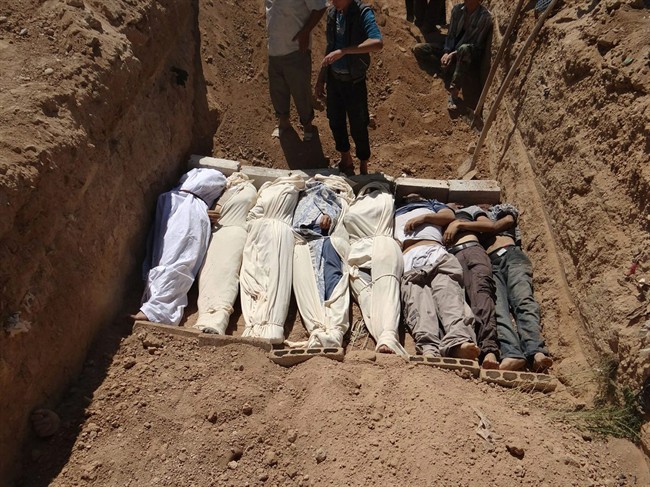TORONTO – There is mounting evidence to support claims that Syria used chemical weapons against civilians last week, killing more than 300 people including children as they lay in their beds.

Médecins Sans Frontières, a medical relief organization, reported that they received about 3,600 patients displaying symptoms of chemical exposure on Aug. 21 while in Syria. Of those, 355 reportedly died.
Chemical weapons, missiles that contain toxic chemicals that can cause death, injury, temporary incapacitation or sensory irritation, first got their modern-day use in World War I when both sides employed poisonous gas to incapacitate or kill the other. Chlorine and mustard gas were put inside artillery shells or grenades and launched across enemy lines.
Since then, chemical weapons have killed nearly one million people around the world.
Not all chemicals are the same. Different chemicals cause different reactions to the body; some are more lethal than others.
Read: Gas attack: What chemical weapons does Syria have, and what does it do with them?
The most well-known chemical agents are: choking agents, blister agents (also called vesicants), blood agents, and nerve agents. Nerve agents are considered to be the most effective as they work quickly and result in the most damage.
Choking agents
clorine and phosogene
Gases damage lung tissue
Blister agents
sulfur mustard, nitrogen mustard, lewisite and phosgene oxime
Spread via liquid or vapour and may last for days. Mustard agents and phosgene have delayed effects. Few deaths, but many casualties. Blindness and permanent damage to the respiratory system.
Blood agents
Hydrogen cyanide, cyanogen chloride and arsine
Through inhalation, but spread throughout the blood. They cause the body to fail to use and transfer oxygen, causing the body to suffocate.
Nerve agents
Tabun, sarin, soman, GF and VX
Relatively stable and easily spread, nerve agents are highly toxic and act rapidly.
Due to the symptoms that were observed of the victims and the deaths, it is widely believed that sarin was used against the Syrian people last week.
“It’s known that in the Syrian government’s arsenal are the nerve agents sarin and VX,” said Dr. Walter Dorin, a professor of Defence Studies at the Royal Military College of Canada and the Canadian Forces College. “They also are known to possess mustard gas and many riot control agents.”
Depending on the concentration of the sarin, how people react to it would be different. The closer to the drop area, the worse the symptoms would be.
“If the attack was right on them… then upon release, they’d hardly have a moment to feel symptoms,” Dorn said. “If it was less concentrated they’d start gagging and some people would probably wake up and they’d start moving around like zombies, wondering what to do.”
Asked what the initial symptoms the victims would experience, Dorn said, “They would feel breathing problems, collapsed breathing, they’d start…god, this is such gory stuff. In fact, we saw some of the pictures of the Syrian people.” Dorn paused and then continued. “Eventually they’d go into a kind of rigor mortus, paralysis, because their muscles are just tensed all the time and they can’t…I don’t even want to talk about it anymore.”
Dorn believes that, due to the variety of symptoms reported, the bomb had more than just pure sarin in it, such as tear gas.
“VX is so strong that a drop on your skin would kill you,” he continued. “And sarin is very volatile, so even if you breathe it in, it could kill you. But it requires a high concentration, so sarin is better for delivery for chemical weapons.”
Even if the sarin doesn’t kill you, the long-term effects of exposure could result in damage to your nervous system.
There are two components to making sarin. Each is kept separately. Once the two are mixed together, it has a limited life. Concern mounted months ago when it was discovered that Syria had already mixed the ingredients to sarin.
“There were reports about four of five months ago that they were mixing the chemicals and it was like the clock started ticking because once you mix it into sarin… it reacts strongly with oxygen, so you have to use them before they degrade.”
People can die within minutes if they are close enough to the high concentration of sarin, said Dorin. If they get lower concentration, it can be hours. If people are even exposed to small amounts, they can suffer for days later.
It is believed that Syria has about 2,000 or 3,000 tonnes of chemical weapons The amount that was likely used on Aug. 21 is estimated to be in the hundreds of kilograms or more.
The only other country known to have used sarin is Iraq, against the Kurds in 1988. The attack killed approximately 5,000 civilians.
Banning chemical weapons
The Geneva Protocol of 1925 banned the use of chemical weapons. However, the Protocol didn’t prohibit the development, production or stockpiling of the weapons. By the 1970s and ’80s nearly 25 countries around the world – including Canada – had chemical weapons capabilities.
However, during the 1980s and 1990s, mounting concern over the use of chemical weapons was expressed by many countries in the United Nations. In 1992, the UN agreed to set up a preparatory commission for the future Organisation for the Prohibition of Chemical Weapons (OPCW).
In 1997, under the OPCW, the Chemical Weapons Convention (CWC) became binding international law. The CWC bans the production, stockpiling, and use of chemical weapons and has been signed by 189 countries. Only Angola, Egypt, North Korea, South Sudan and Syria have not signed or acceded to the CWC. Israel and Myanmar have not yet ratified the CWC.
The first international agreement limiting the use of chemical weapons goes back to 1675 when France and Germany agreed to prohibit the use of poison bullets.


Comments